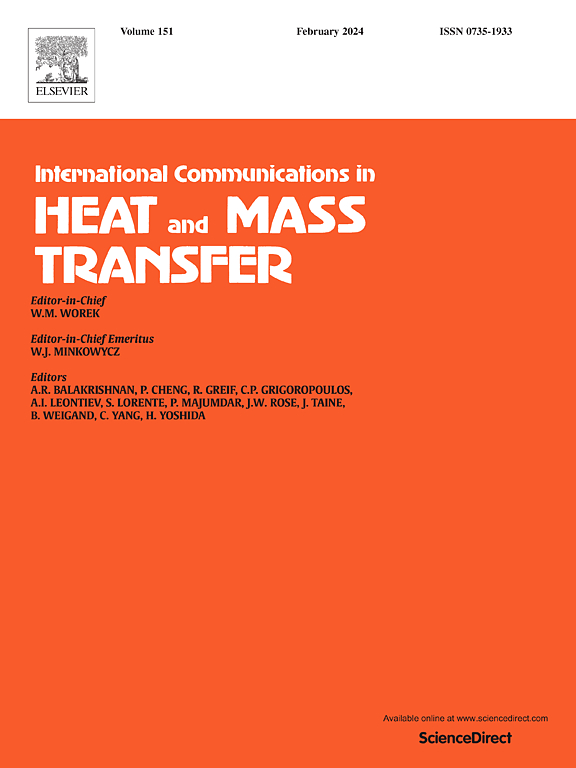Enhancing the performance of air-based photovoltaic / thermal (PV/T) heaters using baffles and metal foam
IF 6.4
2区 工程技术
Q1 MECHANICS
International Communications in Heat and Mass Transfer
Pub Date : 2025-09-10
DOI:10.1016/j.icheatmasstransfer.2025.109574
引用次数: 0
Abstract
Photovoltaic/thermal (PV/T) heaters simultaneously produce electricity and heat, offering a promising solution to energy shortages and pollution. However, air's low thermal capacity limits its cooling effectiveness on PV modules, reducing overall PV/T performance. To overcome this, we performed numerical simulations to assess the combined impact of corrugated baffles and metal foam on the thermal and electrical performance of air-based PV/T heaters. A user-defined function (UDF) correlated module temperature with electrical efficiency, and model accuracy was confirmed against benchmark temperature and pressure-drop data. We examined the effects of mass flow rate (0.0116–0.0696 kg/s), metal foam configuration, and foam thickness on heater performance, and elucidated the foam's heat-transfer enhancement mechanism. Results showed that the high effective thermal conductivity of the foam accelerated heat removal in vortex regions, mitigating hot spots on the PV surface. Compared to a baffled channel alone, adding metal foam increased thermal efficiency by 3.03–7.69 %, electrical efficiency by 0.60–2.31 %, and total efficiency by 3.63–8.45 %. However, thicker foam raised flow resistance – boosting velocity and pressure loss - which diminished net efficiency gains at greater thicknesses.
利用挡板和金属泡沫提高空气基光伏/热(PV/T)加热器的性能
光伏/热(PV/T)加热器同时产生电和热,为能源短缺和污染提供了一个有希望的解决方案。然而,空气的低热容量限制了其对光伏组件的冷却效果,降低了PV/T的整体性能。为了克服这个问题,我们进行了数值模拟,以评估波纹挡板和金属泡沫对空气基PV/T加热器热电性能的综合影响。用户定义函数(UDF)将模块温度与电效率相关联,并根据基准温度和压降数据确认模型精度。研究了质量流量(0.0116 ~ 0.0696 kg/s)、金属泡沫形态和泡沫厚度对加热器性能的影响,并阐明了泡沫的强化传热机理。结果表明,泡沫材料的高效导热系数加速了涡流区的热量去除,减轻了PV表面的热点。与单独的挡板通道相比,添加金属泡沫可提高热效率3.03 - 7.69%,电效率0.60 - 2.31%,总效率3.63 - 8.45%。然而,较厚的泡沫会增加流动阻力,增加速度和压力损失,从而降低了较厚泡沫的净效率。
本文章由计算机程序翻译,如有差异,请以英文原文为准。
求助全文
约1分钟内获得全文
求助全文
来源期刊
CiteScore
11.00
自引率
10.00%
发文量
648
审稿时长
32 days
期刊介绍:
International Communications in Heat and Mass Transfer serves as a world forum for the rapid dissemination of new ideas, new measurement techniques, preliminary findings of ongoing investigations, discussions, and criticisms in the field of heat and mass transfer. Two types of manuscript will be considered for publication: communications (short reports of new work or discussions of work which has already been published) and summaries (abstracts of reports, theses or manuscripts which are too long for publication in full). Together with its companion publication, International Journal of Heat and Mass Transfer, with which it shares the same Board of Editors, this journal is read by research workers and engineers throughout the world.

 求助内容:
求助内容: 应助结果提醒方式:
应助结果提醒方式:


